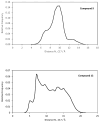Combination of Betulinic Acid Fragments and Carbonic Anhydrase Inhibitors-A New Drug Targeting Approach
- PMID: 38543295
- PMCID: PMC10974084
- DOI: 10.3390/pharmaceutics16030401
Combination of Betulinic Acid Fragments and Carbonic Anhydrase Inhibitors-A New Drug Targeting Approach
Abstract
Human carbonic anhydrase IX (hCA IX) is a zinc(II)-dependent metalloenzyme that plays a critical role in the conversion of carbon dioxide and water to protons and bicarbonate. It is a membrane-bound protein with an extracellular catalytic center that is predominantly overexpressed in solid hypoxic tumors. Sulfamates and sulfonamides, for example acetazolamide (AZA), have been used to inhibit hCA IX in order to improve the response to solid hypoxic tumors. In the present study, we propose a new drug targeting approach by attaching the natural cytotoxic substances betulin and betulinic acid (BA) via a linker to sulfonamides. The conjugate was designed with different spacer lengths to accumulate at the target site of hCA IX. Computational and cell biological studies suggest that the length of the linker may influence hCA IX inhibition. Cytotoxicity tests of the newly synthesized bifunctional conjugates 3, 5, and 9 show effective cytotoxicity in the range of 6.4 and 30.1 µM in 2D and 3D tumor models. The hCA IX inhibition constants of this conjugates, measured using an in vitro enzyme assay with p-nitrophenyl acetate, were determined in a low µM-range, and all compounds reveal a significant inhibition of hypoxia-induced CA activity in a cell-based assay using the Wilbur-Anderson method. In addition, the cells respond with G1 increase and apoptosis induction. Overall, the dual strategy to produce cytotoxic tumor therapeutics that inhibit tumor-associated hCA IX was successfully implemented.
Keywords: Carbonic anhydrase IX inhibition; betulin and betulinic acid; dual tumor targeting agents.
Conflict of interest statement
The authors declare no conflicts of interest.
Figures









References
-
- Zdzisińska B., Rzeski W., Paduch R., Szuster-Ciesielska A., Kaczor J., Wejksza K., Kandefer-Szerszeń M. Differential effect of betulin and betulinic acid on cytokine production in human whole blood cell cultures. Pol. J. Pharmacol. 2003;55:235–238. - PubMed
-
- Takada Y., Aggarwal B.B. Betulinic acid suppresses carcinogen-induced NF-kappa B activation through inhibition of I kappa B alpha kinase and p65 phosphorylation: Abrogation of cyclooxygenase-2 and matrix metalloprotease-9. J. Immunol. 2003;171:3278–3286. doi: 10.4049/jimmunol.171.6.3278. - DOI - PubMed
Grants and funding
LinkOut - more resources
Full Text Sources

